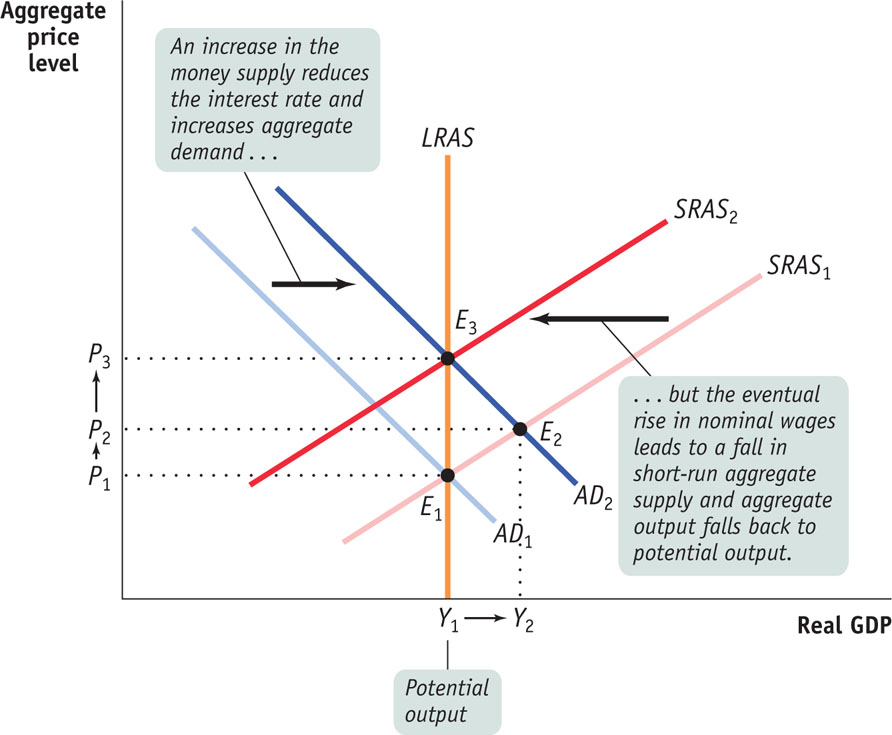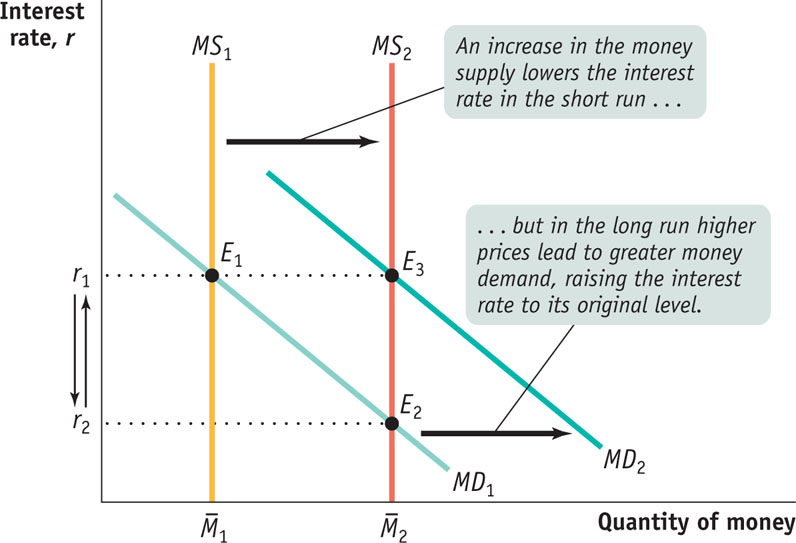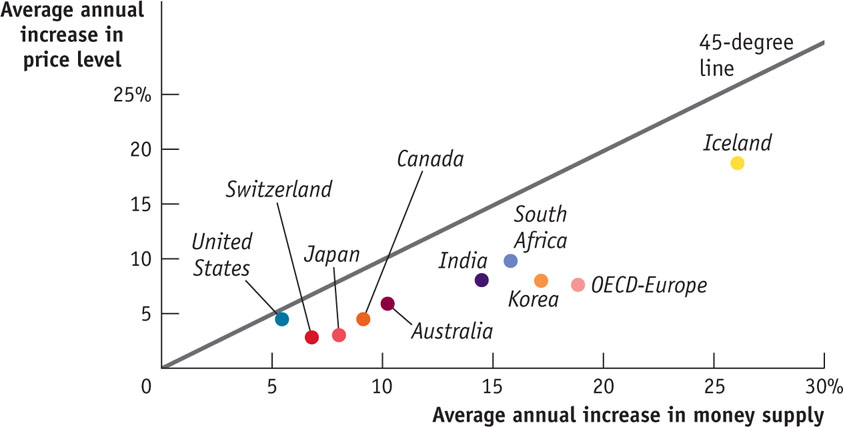Money, Output, and Prices in the Long Run
Through its expansionary and contractionary effects, monetary policy is generally the policy tool of choice to help stabilize the economy. However, not all actions by central banks are productive. In particular, central banks sometimes print money not to fight a recessionary gap but to help the government pay its bills, an action that typically destabilizes the economy.
What happens when a change in the money supply pushes the economy away from, rather than toward, long-run equilibrium? We learned in Chapter 14 that the economy is self-correcting in the long run: a demand shock has only a temporary effect on aggregate output. If the demand shock is the result of a change in the money supply, we can make a stronger statement: in the long run, changes in the quantity of money affect the aggregate price level, but they do not change real aggregate output or the interest rate. To see why, let’s look at what happens if the central bank permanently increases the money supply.
Short-Run and Long-Run Effects of an Increase in the Money Supply
To analyze the long-run effects of monetary policy, it’s helpful to think of the central bank as choosing a target for the money supply rather than the interest rate. In assessing the effects of an increase in the money supply, we return to the analysis of the long-run effects of an increase in aggregate demand, first introduced in Chapter 14.
Figure 17-11 shows the short-run and long-run effects of an increase in the money supply when the economy begins at potential output, Y1. The initial short-run aggregate supply curve is SRAS1, the long-run aggregate supply curve is LRAS, and the initial aggregate demand curve is AD1. The economy’s initial equilibrium is at E1, a point of both short-run and long-run macroeconomic equilibrium because it is on both the short-run and the long-run aggregate supply curves. Real GDP is at potential output, Y1.
FIGURE 17-11 The Short-Run and Long-Run Effects of an Increase in the Money Supply

Here, the economy begins at E1, a point of short-run and long-run macroeconomic equilibrium. An increase in the money supply shifts the AD curve rightward, and the economy moves to a new short-run macroeconomic equilibrium at E2 and a new real GDP of Y2. But E2 is not a long-run equilibrium: Y2 exceeds potential output, Y1, leading over time to an increase in nominal wages. In the long run, the increase in nominal wages shifts the short-run aggregate supply curve leftward, to a new position at SRAS2.
The economy reaches a new short-run and long-run macroeconomic equilibrium at E3 on the LRAS curve, and output falls back to potential output, Y1. When the economy is already at potential output, the only long-run effect of an increase in the money supply is an increase in the aggregate price level from P1 to P3.
Now suppose there is an increase in the money supply. Other things equal, an increase in the money supply reduces the interest rate, which increases investment spending, which leads to a further rise in consumer spending, and so on. So an increase in the money supply increases the quantity of goods and services demanded, shifting the AD curve rightward, to AD2. In the short run, the economy moves to a new short-run macroeconomic equilibrium at E2. The price level rises from P1 to P2, and real GDP rises from Y1 to Y2. That is, both the aggregate price level and aggregate output increase in the short run.
But the aggregate output level, Y2, is above potential output. As a result, nominal wages will rise over time, causing the short-run aggregate supply curve to shift leftward. This process stops only when the SRAS curve ends up at SRAS2 and the economy ends up at point E3, a point of both short-run and long-run macroeconomic equilibrium. The long-run effect of an increase in the money supply, then, is that the aggregate price level has increased from P1 to P3, but aggregate output is back at potential output, Y1. In the long run, a monetary expansion raises the aggregate price level but has no effect on real GDP.
We won’t describe the effects of a monetary contraction in detail, but the same logic applies. In the short run, a fall in the money supply leads to a fall in aggregate output as the economy moves down the short-run aggregate supply curve. In the long run, however, the monetary contraction reduces only the aggregate price level, and real GDP returns to potential output.
Monetary Neutrality
How much does a change in the money supply change the aggregate price level in the long run? The answer is that a change in the money supply leads to an equal proportional change in the aggregate price level in the long run. For example, if the money supply falls 25%, the aggregate price level falls 25% in the long run; if the money supply rises 50%, the aggregate price level rises 50% in the long run.
How do we know this? Consider the following thought experiment: Suppose all prices in the economy—prices of final goods and services and also factor prices, such as nominal wage rates—double. And suppose the money supply doubles at the same time. What difference does this make to the economy in real terms? The answer is none. All real variables in the economy—such as real GDP and the real value of the money supply (the amount of goods and services it can buy)—are unchanged. So there is no reason for anyone to behave any differently.
We can state this argument in reverse: If the economy starts out in long-run macroeconomic equilibrium and the money supply changes, restoring long-run macroeconomic equilibrium requires restoring all real values to their original values. This includes restoring the real value of the money supply to its original level. So if the money supply falls 25%, the aggregate price level must fall 25%; if the money supply rises 50%, the price level must rise 50%; and so on.
According to the concept of monetary neutrality, changes in the money supply have no real effects on the economy.
This analysis demonstrates the concept known as monetary neutrality, in which changes in the money supply have no real effects on the economy. In the long run, the only effect of an increase in the money supply is to raise the aggregate price level by an equal percentage. Economists argue that money is neutral in the long run.
This is, however, a good time to recall the dictum of John Maynard Keynes: “In the long run we are all dead.” In the long run, changes in the money supply don’t have any effect on real GDP, interest rates, or anything else except the price level. But it would be foolish to conclude from this that the Fed is irrelevant. Monetary policy does have powerful real effects on the economy in the short run, often making the difference between recession and expansion. And that matters a lot for society’s welfare.
Changes in the Money Supply and the Interest Rate in the Long Run
In the short run, an increase in the money supply leads to a fall in the interest rate, and a decrease in the money supply leads to a rise in the interest rate. In the long run, however, changes in the money supply don’t affect the interest rate.
Figure 17-12 shows why. It shows the money supply curve and the money demand curve before and after the Fed increases the money supply. We assume that the economy is initially at E1, in long-run macroeconomic equilibrium at potential output, and with money supply  . The initial equilibrium interest rate, determined by the intersection of the money demand curve MD1 and the money supply curve MS1, is r1.
. The initial equilibrium interest rate, determined by the intersection of the money demand curve MD1 and the money supply curve MS1, is r1.
FIGURE 17-12 The Long-Run Determination of the Interest Rate

 to
to  pushes the interest rate down from r1 to r2 and the economy moves to E2, a short-run equilibrium. In the long run, however, the aggregate price level rises in proportion to the increase in the money supply, leading to an increase in money demand at any given interest rate in proportion to the increase in the aggregate price level, as shown by the shift from MD1 to MD2. The result is that the quantity of money demanded at any given interest rate rises by the same amount as the quantity of money supplied. The economy moves to long-run equilibrium at E3 and the interest rate returns to r1.
pushes the interest rate down from r1 to r2 and the economy moves to E2, a short-run equilibrium. In the long run, however, the aggregate price level rises in proportion to the increase in the money supply, leading to an increase in money demand at any given interest rate in proportion to the increase in the aggregate price level, as shown by the shift from MD1 to MD2. The result is that the quantity of money demanded at any given interest rate rises by the same amount as the quantity of money supplied. The economy moves to long-run equilibrium at E3 and the interest rate returns to r1.Now suppose the money supply increases from  to
to  . In the short run, the economy moves from E1 to E2 and the interest rate falls from r1 to r2. Over time, however, the aggregate price level rises, and this raises money demand, shifting the money demand curve rightward from MD1 to MD2. The economy moves to a new long-run equilibrium at E3, and the interest rate rises to its original level at r1.
. In the short run, the economy moves from E1 to E2 and the interest rate falls from r1 to r2. Over time, however, the aggregate price level rises, and this raises money demand, shifting the money demand curve rightward from MD1 to MD2. The economy moves to a new long-run equilibrium at E3, and the interest rate rises to its original level at r1.
And it turns out that the long-run equilibrium interest rate is the original interest rate, r1. We know this for two reasons. First, due to monetary neutrality, in the long run the aggregate price level rises by the same proportion as the money supply; so if the money supply rises by, say, 50%, the price level will also rise by 50%. Second, the demand for money is, other things equal, proportional to the aggregate price level. So a 50% increase in the money supply raises the aggregate price level by 50%, which increases the quantity of money demanded at any given interest rate by 50%. As a result, the quantity of money demanded at the initial interest rate, r1, rises exactly as much as the money supply—so that r1 is still the equilibrium interest rate. In the long run, then, changes in the money supply do not affect the interest rate.
International Evidence of Monetary Neutrality
These days monetary policy is quite similar among wealthy countries. Each major nation (or, in the case of the euro, the euro area) has a central bank that is insulated from political pressure. All of these central banks try to keep the aggregate price level roughly stable, which usually means inflation of at most 2% to 3% per year.
But if we look at a longer period and a wider group of countries, we see large differences in the growth of the money supply. Between 1970 and the present, the money supply rose only a few percent per year in some countries, such as Switzerland and the United States, but rose much more rapidly in some poorer countries, such as South Africa. These differences allow us to see whether it is really true that increases in the money supply lead, in the long run, to equal percent rises in the aggregate price level.
Figure 17-13 shows the annual percentage increases in the money supply and average annual increases in the aggregate price level—that is, the average rate of inflation—for a sample of countries during the period 1970–2010, with each point representing a country. If the relationship between increases in the money supply and changes in the aggregate price level were exact, the points would lie precisely on a 45-degree line—a line which goes through the origin and has a slope of 1. In fact, the relationship isn’t exact, because other factors besides money affect the aggregate price level. But the scatter of points clearly lies close to a 45-degree line, showing a more or less proportional relationship between money and the aggregate price level. That is, the data support the concept of monetary neutrality in the long run.
FIGURE 17-13 The Long-Run Relationship Between Money and Inflation

Quick Review
- According to the concept of monetary neutrality, changes in the money supply do not affect real GDP, only the aggregate price level. Economists believe that money is neutral in the long run.
- In the long run, the equilibrium interest rate in the economy is unaffected by changes in the money supply.
Check Your Understanding 17-4
Question
Assume the central bank increases the quantity of money by 25%, even though the economy is initially in both short-run and long-run macroeconomic equilibrium. What are the effects, in the short run and in the long run on aggregate output?
A. B. C. D. Aggregate output rises in the short run, then falls back to equal potential output in the long run.Question
Assume the central bank increases the quantity of money by 25%, even though the economy is initially in both short-run and long-run macroeconomic equilibrium. What are the effects, in the short run and in the long run on the aggregate price level?
A. B. C. D. The aggregate price level rises in the short run, but by less than 25%. It rises further in the long run, for a total increase of 25%.Question
Assume the central bank increases the quantity of money by 25%, even though the economy is initially in both short-run and long-run macroeconomic equilibrium. What are the effects, in the short run and in the long run on the interest rate?
A. B. C. D. The interest rate falls in the short run, then rises back to its original level in the long run.
Question
True or False? In the long run monetary policy has no effect on the economy.
A. B. In the short run, a change in the interest rate alters the economy because it affects investment spending, which in turn affects aggregate demand and real GDP through the multiplier process. However, in the long run, changes in consumer spending and investment spending will eventually result in changes in nominal wages and the nominal prices of other factors of production. For example, an expansionary monetary policy will eventually cause a rise in factor prices; a contractionary policy will eventually cause a fall in factor prices. In response, the shortrun aggregate supply curve will shift to move the economy back to long-run equilibrium. So in the long run monetary policy has no effect on the economy.
Solutions appear at back of book.